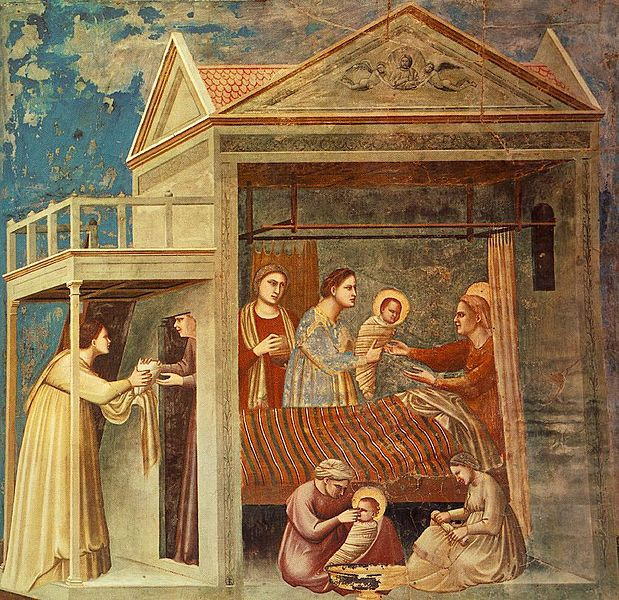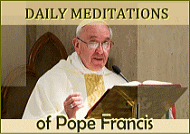September 8, 2015
The readings: Rom. 8:28-30 or Mic. 5:2-5; Mt. 1:16, 18-23
Anecodote: The “Hail Mary” of a Protestant is powerful! — ( This is a true story.)
A little six-year-old Protestant boy had often heard his Catholic companion reciting the prayer ‘Hail Mary.’ He liked it so much that he copied it, memorized it and would recite it every day. ‘Look, Mummy, what a beautiful prayer,’ he said to his mother one day. ‘Never again say it,’ answered the mother.’ it is a superstitious prayer of Catholics who adore idols and think of Mary as a goddess. After all, she is a woman like any other. Take this Bible and read it. It contains everything that we are bound to do and have to do.’
From that day on the little boy discontinued his daily ‘Hail Mary’ and gave himself more time to reading the Bible instead. One day, while reading the Gospel, he came across the passage about the Annunciation of the Angel to Our Lady. Full of joy, the little boy ran to his mother and said: ‘Mummy, I have found the ‘Hail Mary’ in the Bible which says: ‘Hail Mary full of grace, the Lord is with thee, blessed art thou amongst women. ‘ Why do you call it a superstitious prayer?’
On another occasion he found the beautiful Salutation of St. Elizabeth to The Virgin Mary and the wonderful canticle. MAGNIFICAT in which Mary foretold that ‘the generations would call her blessed.’ He said no more about it to his mother but started to recite the ‘Hail Mary’ every day as before. He felt pleasure in addressing those charming words to the Mother of Jesus, our Savior.
When he was fourteen, he one day heard a discussion on Our Lady among the members of his family. Every one said that Mary was a common woman like any other woman. The boy, after listening to their erroneous reasoning, could not bear it any longer, and full of indignation, he interrupted them, saying: ‘Mary is not like any other children of Adam, stained with sin. No! The Angel called her FULL OF GRACE AND BLESSED AMONGST WOMEN. Mary is the Mother of Jesus Christ and consequently Mother of God. There is no higher dignity to which a creature can be raised.
We remember the birthdays of those who are significant for us in life. We also remember the birthday of those who are significant for our faith life. The most significant person in terms of our faith life as Christians is, of course, Jesus, and we remember his birthday on Christmas day. Next to Jesus, Mary is the most significant person for the faith life of many Christians, and it is only fitting that the church remembers her birthday. It is impossible to know when exactly Mary was born, but September 8 has traditionally been the day when the church celebrates Mary’s birthday. When we wish someone a happy birthday we are, in a sense, giving thanks for that person’s birth and life. Today we give thanks for Mary’s birth and life. Today’s Gospel has to do with the birth of Jesus, rather than the birth of Mary, and that is only right and fitting. We celebrate Mary’s birth and life because of the birth of Jesus, because she became the mother of the Saviour. She is the one through whom we receive Emmanuel, God-with-us. Mary doesn’t offer us herself; she offers us her Son. She holds out her Son to us. She would have been happy to make her own the words of John the Baptist in relation to himself: “He, Jesus, must increase, but I must decrease.” The best way to honour Mary is to receive the Son of God whom she offers to us, to become, like herself, people who, in the words of Luke’s gospel, “hear the word, hold it fast in an honest and good heart, and bear fruit with patient endurance.”
There are many Marian feast days celebrated in the Catholic Church, but the principal ones are the Solemnity of Mary the Mother of God, the Presentation of Our Lord in the Temple, the Annunciation, the Assumption, the Immaculate Conception and the Nativity of our Lady. The Feasts of our Lady are dear to us. Before we are born, our mothers are our entire world; they enfold, nourish, and protect us. When we are born they continue to care for us, by comforting, nursing, and teaching us as we grow. Mothers do not stop being mothers just because we are grown. Our mother will always be our mother. So it is with our Blessed Mother, the Virgin Mary. She will always be Jesus’ Mother, and she will always be our Mother with Jesus our brother. And if, for whatever reason, our own birth mother is not quite all we would like her to be, our Blessed Mother stands ready, arms open to take us in. As our Mother, she will continue to nourish, protect, comfort, and teach us as we grow. Daily prayers that greet and thank her for her love and care, and intercessory prayers that ask for her aid, ensure her place in our families, our homes, and our hearts. She is the Mother of God, the Queen of the Saints, the humble spouse of the Church, and attentive patron of hundreds. It is not surprising that there are so many feast days dedicated, to Mary.
The origin of this Feast is sought in Syria or Palestine at the beginning of the 6th century. It goes back to the consecration of a church in Jerusalem, which tradition identifies as that of the present basilica of St. Ann. At Rome the Feast began to be kept toward the end of the 7th century, brought there by Eastern monks. Gradually and in varied ways it spread to the other parts of the West in the centuries that followed. From the 13th century on, the celebration assumed notable importance, becoming a Solemnity with a major Octave and preceded by a Vigil calling for a fast. The Octave was reduced to a simple one during the reform of St. Pius X and was abolished altogether under the reform of Pius XII in 1955.
The present Calendar characterizes the Birth of Mary as an important “Feast” September 8 is specially remembered for social celebrations. It marks the end of summer and beginning of fall, this day has many thanksgiving celebrations and customs attached to it. In the Old Roman Ritual there is a blessing of the summer harvest and fall planting seeds for this day. The winegrowers in France called this feast “Our Lady of the Grape Harvest”. The best grapes are brought to the local church to be blessed and then some bunches are attached to hands of the statue of Mary. A festive meal which includes the new grapes is part of this day. In the Alps section of Austria this day is “Drive-Down Day” during which the cattle and sheep are led from their summer pastures in the slopes and brought to their winter quarters in the valleys. This was usually a large caravan, with all the finery, decorations, and festivity. In some parts of Austria, milk from this day and all the leftover food are given to the poor in honour of Our Lady’s Nativity.
Matthew structured his genealogy to emphasize the right moment for the Messiah’s appearance and the people he would serve. Matthew listed the genealogy in three groups of fourteen; since Jews considered the number “seven” as the complete or perfect number, multiples of “seven” had significance. By using the number in this way, Matthew emphasized the appearance of the Messiah at the right time, the “fullness of time.” It is interesting to note that Jesus himself marked the fourteenth generation in the list. In other words, the last name to appear, number fourteen on the third list of generations, was the Messiah. In Matthew’s eyes, his appearance announced the presence of the end times, the coming of the Kingdom.
The people in the genealogy described not only the character and power of Jesus, they also indicated his mission. He was sent to the poor, the weak, the outcast. The appearance of four women on the list was extraordinary; no ancient man would boast of women in his list of ancestors unless they displayed extraordinary virtue. Tamar, Rahab, Ruth, and Bathsheba (mother of Solomon) may have had outstanding characters, but their stories were flawed, tainted with immorality. Yet, all four had a great impact on their husbands and sons who were key in God’s plans. So, too would Mary. The concept of the virgin birth would raise eyebrows among non-believers. For Matthew, the Christ came despite immorality. Indeed, he came for sinners, so they, too, could have a place in God’s great plan of salvation. The birth of Mary foreshadowed that of her son. She came into the world to bear God’s Son into the world. She was chosen to do the work of the Lord, so her Son could save the world.
The hallmark of Mary’s life was total, loving loyalty to the will of God. This too must be the hallmark of all who call ourselves Christian– and who are baptized into the very life of Christ Jesus, Mary’s son. The final stage of preparation for our Messiah and Redeemer began the day that Mary, daughter of Joachim and Anne, was born. With delight we rejoice in the Lord who has been so gracious to us–through this wonderful woman from Nazareth!
This is a birth and a life worth celebrating!
What does the figure of the Blessed Virgin Mary mean in your life? How do you honor her?
Fr. Gaspar Fernandes, OFM Cap.


